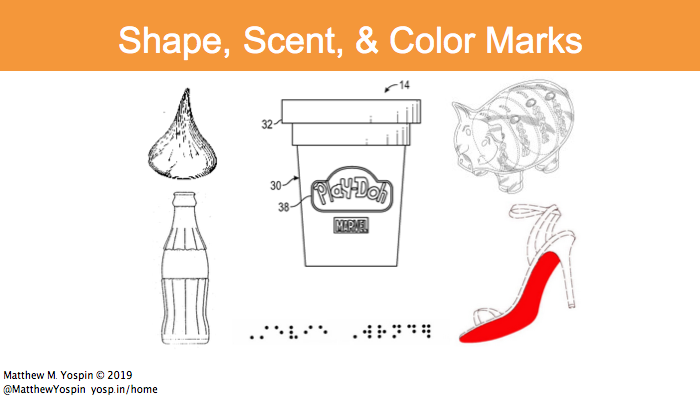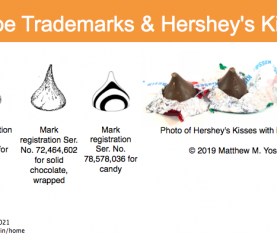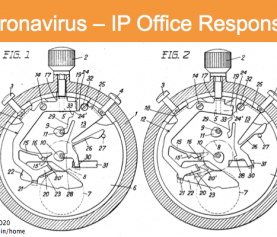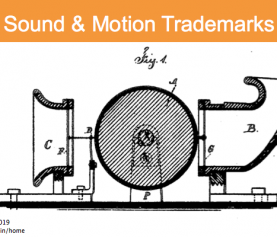Non-traditional trademarks
Most trademarks are for words or images, used as brand names, company names, slogans, or logos, as discussed in several of my posts on trademarks. A trademark can be just about anything that is used to identify an entity as the source of goods or services, including non-traditional trademarks such as shapes, 3-D shapes, scents, colors, sound or motion marks including videos (see my post on non-conventional trademarks focused on sound and motion trademarks), and other types of marks. Trademarks that are not words or non-moving images are often referred to as non-traditional trademarks, or non-conventional trademarks. This post explores some types of non-traditional trademarks, other than sound and motion marks described in my previous post.
Shapes as non-traditional trademarks
The shape of goods can be used as a source-identifier. One favorite example is the shape of Hershey’s Kisses, for which Hershey’s has registered marks for the shapes of different Kisses, such as Ser. No. 74650913 for “candy,” where the mark is the shape of a tapered and tilting Kiss, described as “the configuration of a conically-shaped candy piece approximately 7/8 of an inch high as measured from the base to the pinnacle and 15/16 of an inch in diameter as measured at the base of the candy piece.” Another registration is Ser. No. 78578036, for “candy,” where the mark is described as “the three dimensional configuration of a conically-shaped candy piece with alternating swirls or stripes wrapped around it.” Hershey’s has also registered mark Ser. No. 72464602, for “solid chocolate,” where the mark is “the overall individual wrapping of the goods which take approximately the conformation of the goods.” The tapered Kisses (not the filled or striped ones) were in the news in the fall-winter of 2018-2019, as Hershey’s was having trouble manufacturing the tapered Kisses: they were coming out with broken tips, which was upsetting bakers who use them (truly – there was this story in the New York Times, and more). Because of Hershey’s shape mark registrations, no one else can make similarly shaped/sized candies or chocolates, so bakers could not buy a generic replacement. If Hershey’s didn’t fix their manufacturing process, they could have been deemed to have abandoned their marks (after three years of non-use with intent not to resume use, the legal standard for trademark registration abandonment, link to Legal Information Institute for 15 U.S. Code § 1127, Section 45 of the Lanham Act), but they appear to be fixing the broken-tip problem (again – news coverage, in USA Today, CNBC, and more).
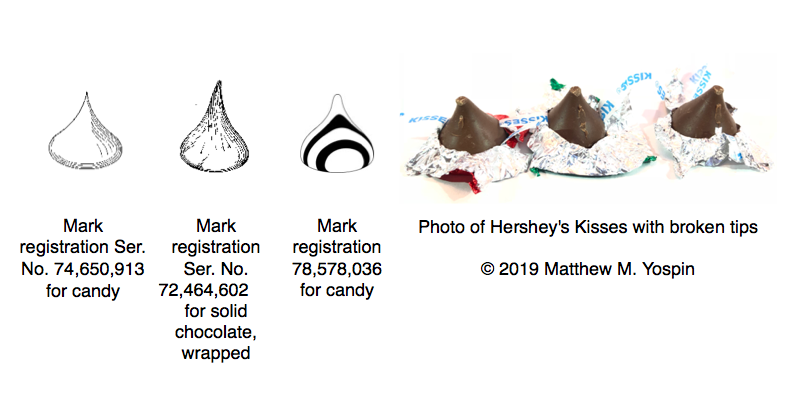
Shape marks can be especially helpful when selling goods that must be packaged. For instance, bottles are a common type of packaging for beverages, including soft drinks, beer, alcohol, tea, coffee, and water, and bottles are the subject of many shape marks. The Coca-Cola Company has registered several marks for “soft drinks” and related goods, such as Serial Numbers:
- 73088384 (“the three dimensional configuration of the distinctive bottle”);
- 74611506 (“a drawing of the outline of a curved contour shaped bottle”);
- 74611507 (“a drawing of the negative image of a contour bottle with indentations at the sides of the bottle where a label or word mark would be affixed or applied”);
- 77878543 (“a three dimensional configuration of a modernized version of the Coca-Cola Contour Bottle, rendered as an aluminum bottle having a distinctive curved shape…”); and
- 77818735 (“a three dimensional configuration of a version of the Coca Cola Contour Bottle, rendered as a two-liter bottle”).
The Coca-Cola Co has registered marks related to their “contour bottle” shape, such as Ser. No. 75796806, for “drinking glasses” where “the configuration of the bottom portion of a drinking glass, namely, a series of concave connecting flutes that match the flutes used on the famous COCA-COLA contour bottle.” They’ve also registered Ser. No. 85226870, which looks like a recycling symbol using their “contour bottle,” for “ketchup; tea” where the mark is “two arrows and a leaf forming the shape of a triangle with the Contour Bottle Design inside the triangle.”
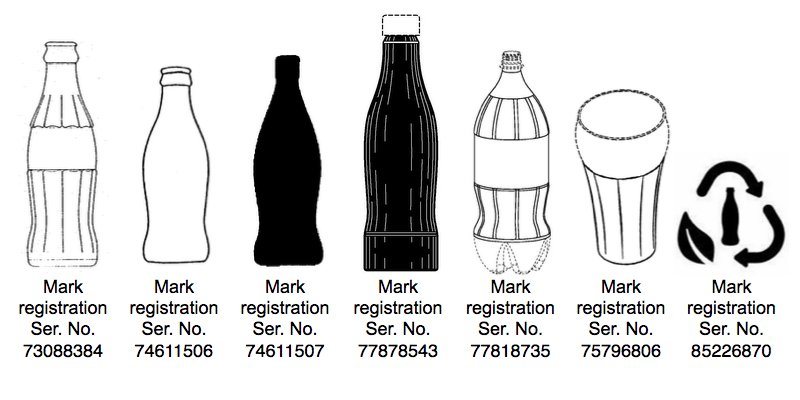
Shape marks are also useful when selling products intended for anyone who is visually impaired or blind, such as marks written entirely or partly in Braille code, which are not classified by the USPTO as written marks (there are currently 82 registration records, not all of which are active or registered). For instance, Ser. No. 77344790 is registered for use with “entertainment services in the nature of live musical performances; and entertainment, namely, live music concerts,” where the mark “consists of the wording STEVIE WONDER in Braille code and the corresponding raised dots.” And unsurprisingly, this mark is registered by Stevland Morris, who is also known as Stevie Wonder. He has also registered Ser. No. 77344758, for “clothing, namely, T-shirts, sweatshirts and hooded sweatshirts.” Both registrations were cancelled in April 2019.
“Stevie Wonder” in Braille text
Three-dimensional trademarks
Though they may be regarded as a subset of shape trademark, or as a closely-related category, there appear to be at most about 1,700 live non-traditional trademark registrations for three-dimensional objects (the number may be closer to 550, the uncertainty coming from the fact that there’s no particular code identifying three-dimensional trademark registrations, and many two-dimensional marks have drawings or images of three-dimensional objects). The requirements for such a registration include submitting a drawing that shows “a single rendition of the mark,” though that requirement can be waived by petition (TMEP 807.10), and describing the mark as a three-dimensional configuration of an object, and describing the object.
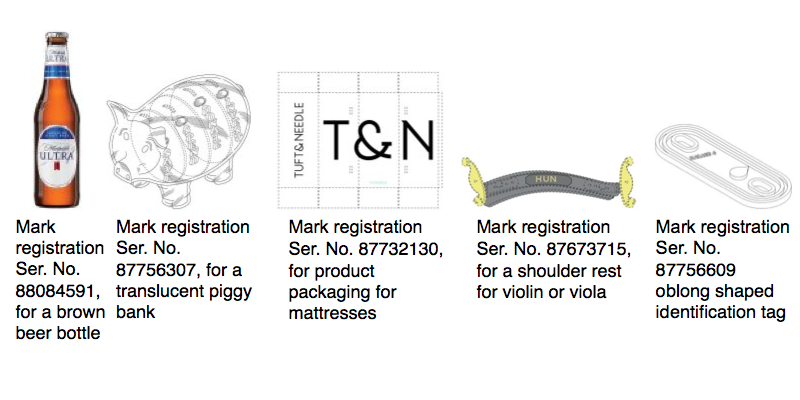
Scents as non-traditional trademarks
Using a scent as a trademark for goods or services is uncommon, but there are examples of non-traditional trademarks registered for aromas in the U.S. As with other marks, the scent must be described well, must function as a mark, and cannot be generic for the goods or services (for instance, you couldn’t register the scent of chocolate if you’re selling chocolate). A leading example is registered by Hasbro as Ser. No. 87335817, for “toy modeling compounds,” where the mark is described as “a scent of a sweet, slightly musky, vanilla fragrance, with slight overtones of cherry, combined with the smell of a salted, wheat-based dough.” You probably recognize the scent, even if the description of it takes a moment to process: it’s the smell of Play-Doh. Of course, Hasbro has multiple trademark registrations for word marks and logos, but their registration for the scent of Play-Doh stands out, both for its wine-tasting-menu description, and the length of time it has been in use (since Sep. 12, 1955).
Other non-traditional trademark registrations for scent marks include:
- Ser. No. 86467988, for “retail store services featuring jewelry…” where the mark “consists of the scent of chocolate” (currently on the Supplemental Register) – because while you can’t register the smell of chocolate for selling chocolate, you may be able to register it for use with other goods or services.
- Ser. No. 86265443, for “shoes, sandals, flip flops, and … flip flop bags” where the mark “consists of the scent of bubble gum” (currently on the Supplemental Register).
- three marks, registered to an individual in Texas, for lubricants and motor fuels (variously), where the marks are described as a “grape scent” for Ser. No. 75360104; as a “strawberry scent” for Ser. No. 75360102; and as a “cherry scent” for Ser. No. 74720993.
With scent trademarks, and other non-traditional trademarks that are completely non-visual such as sound trademarks, you do not have to submit a drawing of the mark, following TMEP 807.09. The “drawings” in the USPTO’s records for the marks described above are the text “SCENT MARK,” or “NON-VISUAL PLAY-DOH SCENT MARK” or similar, or are simply blank.
Colors as non-traditional trademarks
A color, or more than one, can be registered as a non-traditional trademark provided that its use meets the criteria for registration. Some well-known marks that are registered for color include several marks registered by Owens-Corning for their insulation and building products, where they use the color pink to distinguish their products in a marketplace. These include registrations for which the mark “consists of the color pink as applied to the entirety of the goods,” such as Ser. Nos. 75639297 (“building insulation,” in use since 1956); 75544715 (“extruded polystyrene attic rafter vents”); 75050728 (“foam insulation”); 73247707 (“fibrous glass residential insulation”); 78724143 (“adhesive masking tape…” for which the description names the adhesive tape, not just ‘the goods’); and 85306082 (“spray foam sealant…”). Owens Corning has also registered Ser. No. 78018788, for “roofing shingles,” where the mark “consists of the color pink as applied to substantially the entire surface of the packaging of the goods,” which makes sense because that indicates Owens Corning as the seller of the shingles, without making the shingles themselves pink – which might limit their market a bit. The insulation products are all bright pink, and of course are typically covered once they are used, but the marks still work well to identify Owens Corning as the seller when anyone is buying their products.
Another use of color as a non-traditional trademark is the color red with shoe soles, by the fashion designer Christian Louboutin, in Ser. No. 77141789, for “women’s high fashion designer footwear,” where the mark “consists of a red lacquered outsole on footwear that contrasts with the color of the adjoining (“upper”) portion of the shoe.” Louboutin has also used “a shoe sole design colored red” as a mark for a variety of other items, in registrations 79030715 and 85700861.
Other registrations of colors as non-traditional trademarks include:
- Ser. No. 86817708, registered by The Gillette Company, for orange with “razor blade cartridges.”
- Ser. No. 87379170, registered by the U.S. Marine Corps, for blue with a red stripe with “Cell phone cases” and more.
- Ser. No. 86765750, registered by Glaxo, for purple with “Inhalers filled with pharmaceutical preparations.”
- Ser. No. 88084649, registered by Innovative Medical Products, for green with “Clamps for surgical use.”
- Ser. No. 87886098, registered by Duracell, for copper color with “batteries.”
- Ser. No. 87478704, registered by Rawlings Sporting Goods, for metallic gold color with “Baseball gloves and mitts.”
- Ser. No. 88014357, registered by Meyer Sound Laboratories, for blue with “Loudspeakers.”
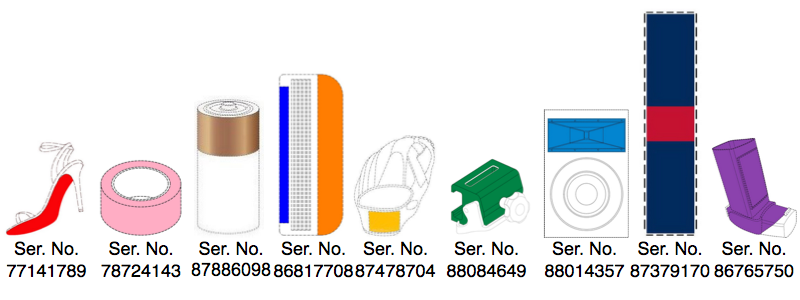
Other non-traditional trademarks
Other types of non-traditional trademarks exist, such as touch marks for the texture of objects, trade dress for product designs or configurations, and possibly marks for the taste of an object. As technologies and inventions continue, other types of marks will likely become possible in the future. The use of non-conventional trademarks or non-traditional trademarks should be reviewed closely, for compliance with the use and notice requirements for registered (or unregistered) marks – take a look at my post on using registered marks for more info. As with other types of marks, you can register a non-traditional trademark with an intent-to-use status to reserve your right to use the mark. When considering registration of non-traditional trademarks, you should carefully review which Classes of goods and services you use or plan to use the mark with – see my post on trademark classes for more.
Do you have questions about creating, registering, or using non-traditional trademarks? I’d be glad to hear from you: call me at 617-340-9295 or email me at my Contact Me page. Or, find me on Facebook, Twitter, LinkedIn, Google Local, or Avvo. The images used in this post relate to the trademarks used as examples, and names may be marks and property of their respective owners. In the image at the top of this post, the images are from trademark registrations referred to in the post, and a patent illustration from US Patent 10,220,324, issued on March 5, 2019 to Hasbro for a “Play apparatus and methods featuring modeling compound can actuating toy items” – because it is hard to show an image of a trademark registration for a scent, but Hasbro has protected other aspects of Play-Doh.


